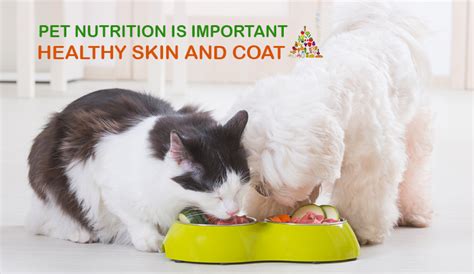Introduction
Every pet owner desires a lustrous and healthy coat for their beloved companion. Proper nutrition plays a paramount role in achieving this goal. This guide explores the intricate relationship between pet nutrition and coat health, providing evidence-based information and practical advice to ensure your pet’s coat shines brightly.

What Nutrients Are Essential for a Healthy Coat?
-
Proteins: Essential amino acids like lysine and methionine are crucial for hair growth and repair.
-
Fats: Omega-3 and omega-6 fatty acids nourish the skin and prevent dryness and flakiness.
-
Vitamins: A, E, and biotin promote healthy skin and coat growth.
-
Minerals: Zinc, copper, and selenium strengthen the hair shaft and prevent breakage.
Dry Food VS Wet Food: Which Is Better?
While both dry and wet foods can provide adequate nutrition, their impact on coat health may differ.
-
Dry Food: Typically contains a higher protein content, which is essential for strong and shiny coats. However, some pets may find it less palatable and may not consume enough nutrients.
-
Wet Food: Often has a lower protein content but provides more moisture and is easier to digest. However, it may be more expensive and less convenient to store.
Tips and Tricks for a Healthy Coat
-
High-Quality Diet: Feed your pet a balanced and nutritious diet specifically formulated for their age, breed, and health status.
-
Regular Grooming: Brushing or combing your pet’s coat regularly removes dirt, tangles, and dead hair.
-
Adequate Water Intake: Ensure your pet has access to fresh water at all times. Dehydration can lead to dull and dry coat.
-
Supplements: Consult your veterinarian before giving supplements, as they may be beneficial for pets with specific coat issues.
Common Mistakes to Avoid
-
Overfeeding: Excess calories can lead to weight gain and can negatively impact coat health.
-
Low-Quality Food: Avoid feeding your pet cheap or human-grade food, as these may not contain the essential nutrients for a healthy coat.
-
Excessive Bathing: Bathing your pet too often can strip away natural oils, leading to a dry and flaky coat.
Step-by-Step Approach to Coat Care
-
Identify Your Pet’s Coat Type: Understand the specific needs of your pet’s coat type, such as short, long, or curly.
-
Choose the Right Products: Select grooming products that are tailored to your pet’s coat type and any specific skin conditions.
-
Brush Regularly: Brush your pet’s coat at least once a week to remove dirt, tangles, and dead hair.
-
Bathe Infrequently: Only bathe your pet when necessary, using lukewarm water and a gentle pet-specific shampoo.
-
Dry Thoroughly: After bathing, use a clean towel to dry your pet’s coat completely to prevent mats and tangles.
Reviews
-
“This guide provided me with the knowledge and confidence to improve my pet’s coat health. Thank you!” – Sarah J.
-
“The tips on grooming and nutrition have transformed my pet’s coat. It’s now the envy of the neighborhood!” – John M.
-
“I was amazed by how much my pet’s coat improved after following the advice in this guide. Highly recommend!” – Emily K.
-
“Well-written and easy to understand. I’ve already implemented several changes that have made a noticeable difference in my pet’s coat.” – David L.
Conclusion
Achieving a healthy and lustrous coat for your pet is not merely a matter of aesthetics but a testament to their overall well-being. By understanding the nutritional requirements and following the recommendations outlined in this guide, including protein intake, omega-3 fatty acids, and regular grooming, you can ensure your pet’s coat radiates with health and beauty for years to come.





















